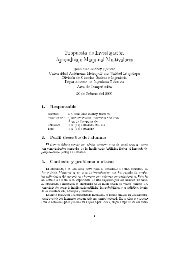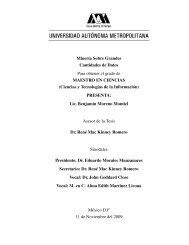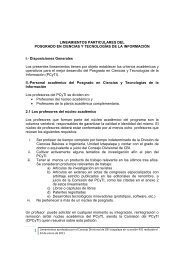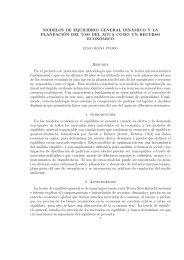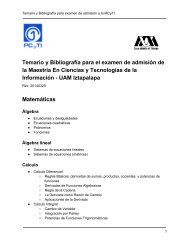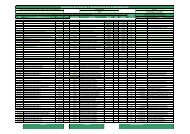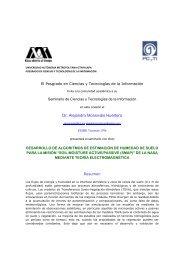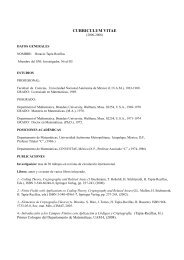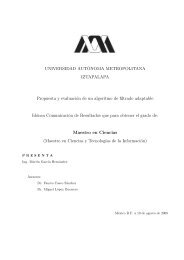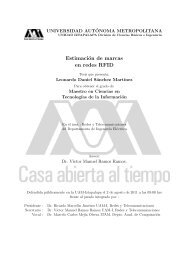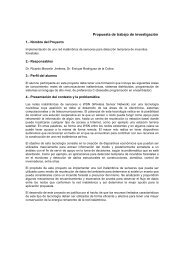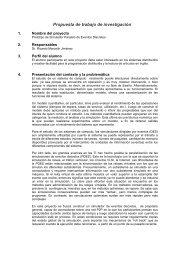enriquecimiento del conocimiento previo en programación lógica ...
enriquecimiento del conocimiento previo en programación lógica ...
enriquecimiento del conocimiento previo en programación lógica ...
Create successful ePaper yourself
Turn your PDF publications into a flip-book with our unique Google optimized e-Paper software.
Refer<strong>en</strong>cias[1] S. ANTHONY AND A. M. FRISCH, G<strong>en</strong>erating numerical literals during refinem<strong>en</strong>t, in Inductive LogicProgramming: 7th International Workshop, ILP-97, Springer Verlag, 1997, pp. 61–76.[2] S. AUGIER, G. VENTURINI, AND Y. KODRATOFF, Learning first order logic rules with a g<strong>en</strong>eticalgorithm, in in Proc. 1st Int. Conf. on Knowledge Discovery and Data Mining, AAAI Press, 1995,pp. 21–26.[3] H. BLOCKEEL AND L. D. RAEDT, Lookahead and discretization in ilp, in In Proceedings of the 7thInternational Workshop on Inductive Logic Programming, Springer-Verlag, 1997, pp. 77–85.[4] , Top-down induction of logical decision trees, in Artificial Intellig<strong>en</strong>ce, 1998.[5] M. BOTTA AND A. GIORDANA, Smart+: A multi-strategy learning tool, in IJCAI, 1993, pp. 937–945.[6] J. CATLETT, On changing continuous attributes into ordered discrete attributes, in Proceedings of theEuropean working session on learning on Machine learning, New York, NY, USA, 1991, Springer-Verlag New York, Inc., pp. 164–178.[7] P. CLARK AND T. NIBLETT, The cn2 induction algorithm, in MACHINE LEARNING, 1989, pp. 261–283.[8] A. P. DEMPSTER, N. M. LAIRD, AND D. B. RUBIN, Maximum likelihood from incomplete datavia the em algorithm, JOURNAL OF THE ROYAL STATISTICAL SOCIETY, SERIES B, 39 (1977),pp. 1–38.[9] F. DIVINA, M. KEIJZER, AND E. MARCHIORI, A method for handling numerical attributes in gabasedinductive concept learners, in Proceedings of the 2003 international confer<strong>en</strong>ce on G<strong>en</strong>etic andevolutionary computation: PartI, GECCO’03, Berlin, Hei<strong>del</strong>berg, 2003, Springer-Verlag, pp. 898–908.[10] F. DIVINA AND E. MARCHIORI, Evolutionary concept learning, in GECCO 2002: Proceedings of theG<strong>en</strong>etic and Evolutionary Computation Confer<strong>en</strong>ce, W. B. Langdon, E. Cantú-Paz, K. Mathias, R. Roy,D. Davis, R. Poli, K. Balakrishnan, V. Honavar, G. Rudolph, J. Weg<strong>en</strong>er, L. Bull, M. A. Potter, A. C.Schultz, J. F. Miller, E. Burke, and N. Jonoska, eds., New York, 9-13 July 2002, Morgan KaufmannPublishers, pp. 343–350.[11] , Handling continuous attributes in an evolutionary inductive learner, IEEE Transactions on EvolutionaryComputation, 9 (2005), pp. 31–43.17



